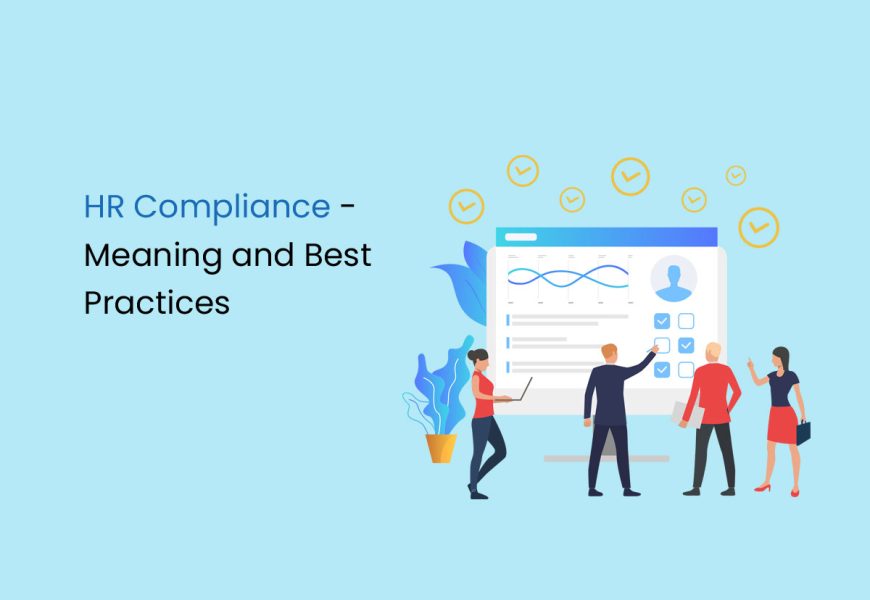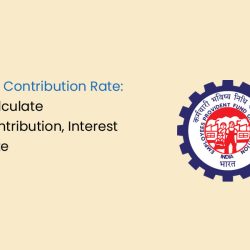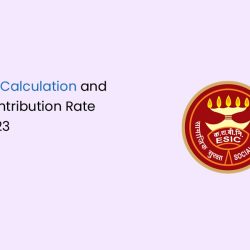The human resources department is a crucial aspect of any organisation. Every organisation must follow specific statutory laws to ensure the welfare of employees and maintain legal compliance. HR compliance plays a significant role in facilitating the smooth functioning of an organisation without any surprises. This includes preventing unforeseen losses resulting from legal complications that arise from non-compliance. It involves creating a credible work environment that adheres to legal standards, promotes fairness, and safeguards the rights of employees.
Let’s discuss HR Compliance in detail – its meaning, challenges and best practices.
What is HR Compliance?
HR compliance is ensuring that an organisation adheres to the labour and employee laws of the state by putting in place relevant policies and systems. For example, regarding employee work hours, HR teams must comply with the specific labour laws governing such matters. Even when there’s an urgent deadline to meet, a company cannot ignore the rights of its employees.
Similarly, companies must consider applicable tax laws when calculating salary components and deductions. This involves considering provident funds, medical insurance, and reimbursements.
For example, the leave duration offered may exceed the law’s requirements, depending on the organisation’s policy.
Non-compliance with laws and regulations can result in business shutdowns and increased costs due to high employee turnover rates. Therefore, organisations must ensure that they comply with HR laws and regulations.
Importance of HR Compliance
HR Compliance is essential due to the following reasons:
- Legal protection and reputation management are crucial aspects of HR compliance. It safeguards businesses from unexpected penalties, fines, and legal disputes by ensuring adherence to relevant laws and, in turn, protects the business’s revenue and legal standing, acting as a shield against potential damage to its reputation.
- HR compliance also guarantees fair treatment of employees without prejudice, fostering a healthy work environment. It protects the rights of employees and prevents workplace discrimination, harassment, and other violations. By creating an inclusive workplace, every employee feels valued and respected.
- Another essential component of HR compliance is conflict resolution. It establishes an unbiased framework for conflict resolution between employees and management, addressing unregulated conduct by senior employees towards juniors due to their positions. It also ensures mechanisms are in place to handle disputes, promoting a harmonious workplace.
- HR compliance includes committees and processes for grievance redressal, providing employees with a platform to voice concerns. It encourages open and transparent communication channels between employees and management, promoting a culture where concerns are addressed promptly and effectively.
- Statutory compliance fosters consistency in HR practices, ensuring uniform application of policies. It enhances transparency in organisational processes, building trust among employees and demonstrating a commitment to ethical and fair employment practices.
- The strengthening of compliance practices contributes to employee commitment to the organisation. Employees are more likely to trust an organisation prioritising their rights and well-being. It helps build a positive organisational culture, fostering loyalty and a sense of belonging.
What is HR’s role in compliance?
HR professionals ensure compliance by interpreting labour laws, monitoring policy changes, and educating employees about compliance standards. They collaborate with legal advisors to stay updated on statutory compliance requirements and play a crucial role in handling complaints, conducting internal audits, and driving a culture of compliance throughout the organisation.
Challenges in HR Compliance
The challenges that HR teams face while ensuring compliance are as follows:
- Continuous Learning Amid Legal Changes: Labour and business laws are constantly changing. Frequent revisions and updates, such as changes in income tax laws impacting salary calculations, demand a proactive approach to staying informed. The ongoing process of staying updated with amendments to HR-related laws poses a formidable challenge for HR teams.
- Navigating Complex Statutory Requirements: Statutory compliance involves managing a multitude of requirements from different jurisdictions, both local and global, at various levels. Each jurisdiction introduces its own set of laws and regulations, contributing to the complexity of compliance management. Companies must build policies grounded in the legal frameworks of their markets to mitigate these risks.
- Balancing Diverse Recruitment Strategies: HR professionals tasked with the primary goal of talent acquisition face scrutiny regarding the objectivity of their processes. Compliance requirements across various levels may necessitate specific guidelines on gender and diversity in recruitment. Companies must implement recruitment strategies aligning with compliance requirements while meeting broader organisational goals, such as diversity and inclusion.
- Managing Benefits Compliance: Deciding which benefits to provide employees is a critical task that requires HR professionals to assess the legal implications of each option. Managing the complexities of benefits administration is a continuous challenge that demands a thorough comprehension of the legal requirements. It is vital to ensure benefits compliance to prevent legal issues and maintain employee satisfaction.
How to Ensure HR Compliance
You can ensure HR compliance by:
- Document Policies and Procedures: It is essential to create and maintain a comprehensive set of HR policies and procedures that cover recruitment, onboarding, compensation, benefits, performance management, and termination.
- Consistent Application of Policies: Consistently applying written policies is critical. Regular reviews and communication sessions help maintain consistency and keep staff informed.
- Accessibility and Communication: To ensure that all employees have easy access to HR policies, you can create an employee handbook, an intranet portal, or other digital platforms. It’s important to regularly communicate updates, changes, and reminders about the policies through company-wide meetings, emails, or internal newsletters. Encourage employees to ask questions and give feedback to ensure policies are clear and well understood.
- Training and Education: Regularly train employees on HR policies, compliance, and best practices. Cover anti-discrimination, harassment prevention, data privacy, workplace safety, and legal obligations.
- Stay Informed about Legal Changes: HR professionals must stay current on labour laws, regulations, and any changes that could affect HR compliance. It’s a good idea to establish a process for monitoring legal updates to accomplish this. You could subscribe to relevant newsletters, follow industry publications, or consult with legal experts. It’s also important to regularly review and update HR policies and procedures and ensure they align with the latest legal requirements.
- Conduct Regular Compliance Audits: A system of regular compliance audits is recommended to evaluate the effectiveness of HR policies, procedures, and practices. Through audits, HR teams can identify gaps or areas of non-compliance in advance, enabling them to take corrective measures promptly. Engaging internal or external auditors with expertise in HR compliance is crucial to ensure a comprehensive review.
- Leverage Technology and Automation: Consider investing in HR software or compliance management tools to streamline HR processes, automate compliance-related tasks, help with payroll calculations, leave management, documentation, reporting, and staying updated with changing regulations.
Best practices for HR compliance
The best practices for HR compliance are as follows:
- It’s essential to keep up-to-date with laws and regulations to ensure accurate policy formulation. The Union Budget may also change tax slabs, and employers must stay informed.
- Training HR staff on compliance requirements is essential, as they are crucial in identifying and mitigating compliance risks. The training should cover all aspects of HR compliance, including recruitment, hiring, onboarding, performance management, compensation and benefits, and termination of employment.
- Automating HR processes with software can improve accuracy and efficiency and enable HR staff to focus on essential tasks.
- Foster a culture of legal compliance in HR through effective communication, training, and leading by example.
- Establish strong partnerships with legal experts to stay informed about legal changes and seek guidance when needed.
- Regularly review and update employee handbooks, policies, and procedures to align with evolving legal requirements and organisational needs.
HR Compliance Checklist
You can ensure HR compliance by following this checklist of the best practices:
- Document Policies and Procedures: Maintaining updated policies and procedures is crucial to ensure legal compliance.
- Consistent Application of Policies and Procedures: Compliance culture can be fostered through frequent communication and training if HR policies are followed top-down.
- Remove Barriers: Making policies accessible and communicating updates can help employees understand and comply with the established guidelines.
- Provide Training: This training enhances employees’ understanding of compliance expectations, covering anti-discrimination, sexual harassment prevention, and data privacy.
- Stay Updated with Laws and Regulations: HR professionals should monitor legal changes, consult legal experts, and adjust policies accordingly.
- Conduct Regular Compliance Audits: Regular compliance audits ensure HR compliance. These audits assess the effectiveness of existing policies and systems, identify areas that require improvement, and help mitigate potential risks.
Conclusion
Ensuring that your company complies with tax and labour laws is crucial to creating a safe and secure workplace for your employees, providing them with fair compensation, and fulfilling your tax obligations. Staying up-to-date with the changing regulations and rulings related to HR compliance can also help prevent errors that may leave your company vulnerable to legal action.
Frequently Asked Questions
How do I check my HR compliance?
The checklist for all the Acts a business must comply with are as follows:
- The Minimum Wages Act, 1948
- The Equal Remuneration Act, 1976
- The Maternity Benefit Act, 1961
- The Employees' Provident Funds Act, 1952
- The Employees' State Insurance Act, 1948
- The Sexual Harassment of Women at Workplace (Prevention, Prohibition, and Redressal) Act, 2013
What is an HR audit checklist?
An HR audit checklist keeps track of all the compliances that have been followed and what more needs to be done for the HR department.
What is an HR Compliance Audit?
An HR compliance audit reviews a company's practices to ensure they follow relevant employment laws. An HR compliance audit checks if a company follows employment laws, covering recruitment, hiring, benefits, pay, safety, and employee interactions. It helps companies prevent legal disputes and ensure fair treatment and a safe work environment for employees.
Why is HR compliance essential?
HR compliance is crucial because it helps avoid penalties, fines, and legal troubles.
How do I ensure HR compliance?
Proper documentation of policies, thorough training, and keeping up with changing HR regulations can help HR leaders stay current on their responsibilities, allow all employees to follow policies and rules, and avoid misconduct.
Why is compliance substantial in HR?
Ensuring HR compliance with tax and labour regulations helps companies provide employees with a safe and secure environment and promotes fair labour practices, equitable hiring, and equal pay.
What does an HR compliance specialist do?
An HR compliance specialist is an expert in work-related legislation, health and safety practices, industry regulations and more, and can audit a company’s policies and procedures to ensure it adheres to these requirements.
What are HR compliance reports?
An HR compliance report provides an overview of a company's policies and practices, highlighting potential violations of labour, tax, and workplace safety regulations.
Also Read
- Payroll Process – Basics, Requirements, Compliances
- HR Policies – A Roadmap for Organisational Success
- What is Payroll Management System? – Definition and Importance


























